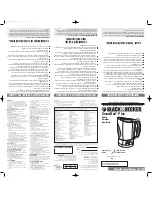
10.
CARE AND CLEANING
Cooking equipment must be cleaned
regularly to maintain its fast, efficient
cooking performance and to ensure its
continued safe, reliable operation. The
best time to clean is shortly after each
use (allow unit to cool to a safe
temperature).
WARNINGS
Do not use
detergents or
cleansers that are
chloride based or
contain quaternary
salt.
Unit should never be
cleaned with a high
pressure spray hose.
Steel wool should
never be used for
cleaning the stainless
steel.
Do not leave water
sitting in unit when
not in use.
Do not use a metal
bristle brush or
scraper.
CLEANING INSTRUCTIONS
CLEANING INSTRUCTIONS
1.
Turn unit off.
2.
Remove drain screen (if applicable). Thoroughly wash and rinse the screen either in
a sink or a dishwasher.
3.
Prepare a warm water and mild detergent solution in the unit.
4.
Remove food soil using a nylon brush.
5.
Loosen food which is stuck by allowing it to soak at a low temperature setting.
6.
Drain unit.
7.
Rinse interior thoroughly.
8.
If the unit is equipped with a Tangent Draw-Off Valve, clean as follows:
a)
Disassemble the draw-off valve first by turning the valve knob counter-clockwise,
then turning the large hex nut counter-clockwise until the valve stem is free of
the valve body.
b)
In a sink, wash and rinse the inside of the valve body using a nylon brush.
c)
Use a nylon brush to clean tangent draw-off tube.
d)
Rinse with fresh water.
e)
Reassemble the draw-off valve by reversing the procedure for disassembly. The
valve's hex nut should be hand tight only.
9.
If the unit is equipped with a Butterfly Valve, clean as follows:
a)
Place valve in open position.
b)
Wash using a warm water and mild detergent solution.
c)
Remove food deposits using a nylon brush.
d)
Rinse with fresh water.
e)
Leave valve open when unit is not in use.
10.
If the unit is equipped with an Air Valve, clean as follows:
a)
Open product valve.
b)
Disconnect air hoses.
c)
Remove air cylinder.
d)
Remove valve tee.
e)
Remove all O-rings.
f)
Clean air cylinder, do not submerge in water. Wipe clean and sanitize.
g)
Clean and sanitize tee and O-rings.
h)
Grease and reinstall O-rings.
i)
Reinstall valve tee to kettle outlet.
j)
Reinstall air cylinder to bottom of tee.
k)
Reconnect air hoses.
l)
Close valve and check for alignment.
11.
Clean the scraper blades as follows:
a)
Remove retaining ring and slide scraper blades off agitator arm.
b)
Place parts in a pan of warm water to soak.
c
Clean in a sink, using a warm water and mild detergent solution.
d)
Rinse with fresh water.
e)
Allow to dry thoroughly on a flat, clean surface.
12.
Using mild soapy water and a damp sponge, wash the exterior, rinse, and dry.
NOTES
➩
For more difficult cleaning applications one of the following can be used: alcohol,
baking soda, vinegar, or a solution of ammonia in water.
➩
Leave the cover off when the kettle is not in use.
➩
For more detailed instructions refer to Stainless Steel Equipment Care and Cleaning
(www.nafem.org/resources/stainlesssteelfinal.doc) on Nafem’s website
(www.nafem.org).
DISPOSAL INSTRUCTIONS
This unit is recyclable. Do not dispose in landfill.
The unit may contain rust inhibitor and or antifreeze within the jacket.
Drain unit and dispose following Federal, State and local regulations.
The majority of the unit is composed of stainless steel. Other alloys
and electrical components make up a small percentage of the total.
Follow Federal, state and local regulations for disposal.
Chloride Cleaners
Wire Brush &
Scrapers
Steel Pads
High Pressure
Spray Hose
Stagnant
Water












































